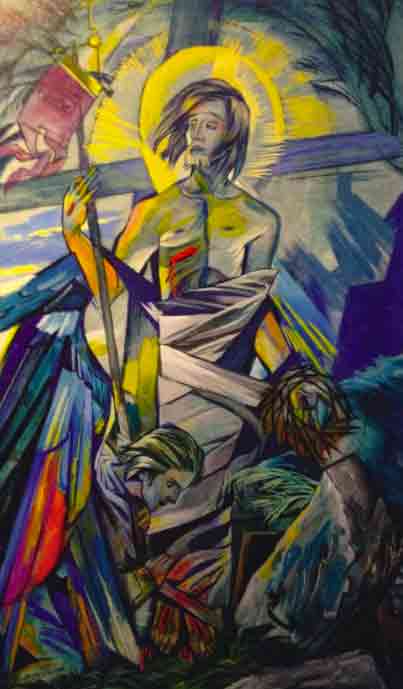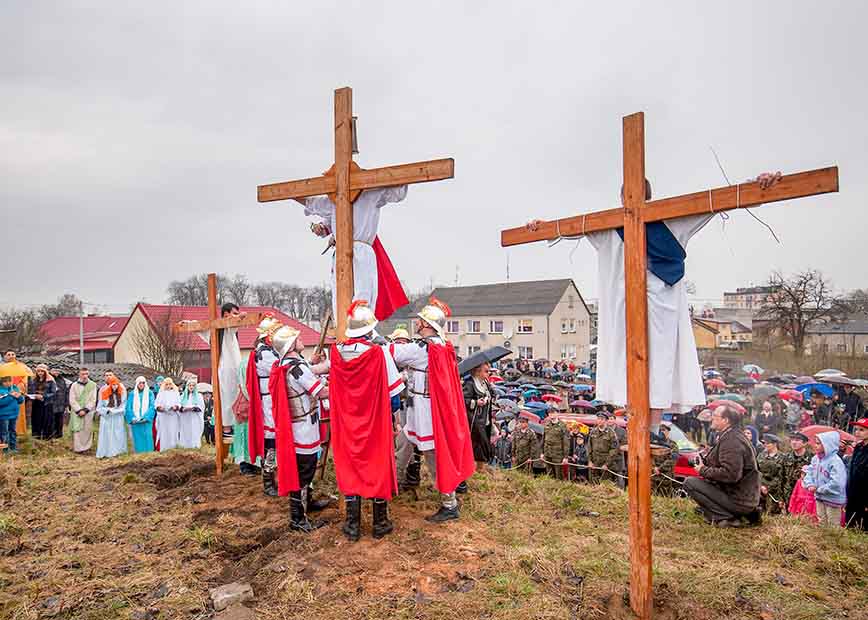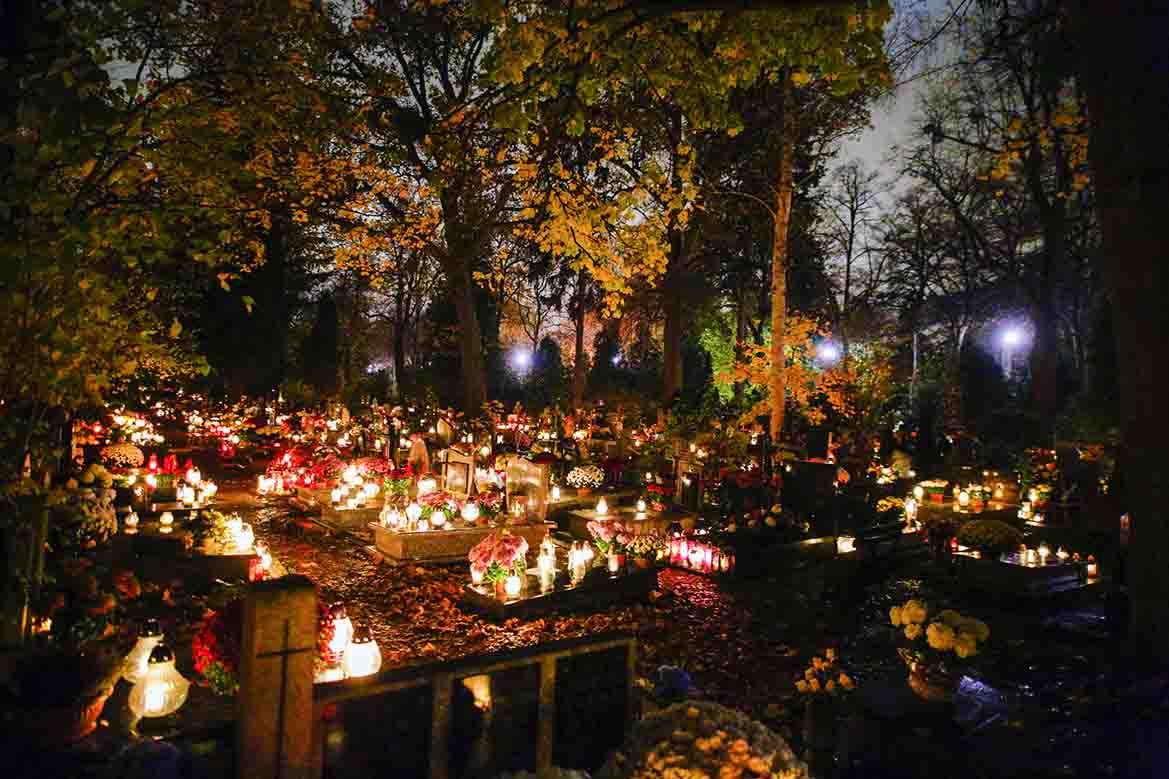Where, O death, is your victory? Where, O death, is your sting?
— 1 Corinthians 15:55-57

Zofia Stryjeńska, Resurrection, oil on canvas, Polish Museum in Chicago
The setting of the events (as envisioned by Daniel Rops, author of the excellent book on Christ):
From the house in the Upper Room, situated at one of the highest points in Jerusalem, there must have been a wide view of all the quarters of the city. Nearby, against the backdrop of the gardens of Gareb, the palace of the high priest and the palace of Herod stood out; opposite, beyond the deep shadow of the Tyropoeon brook, beyond the hill of Ophel and Zion, the heavy mass of Antonia pressed against the foot of the temple, a sign of abuse and harm. Jesus could cover all three stages of his process with one glance. But Golgotha, hidden behind the square block of the David Tower, was not visible from here. The moon of Nisan, the full Passover moon "blessed with deliverance," shone over the dormant city. The guard's flame flickered at the top of Phasael's tower. In the shadow of a guard post, Judas also kept watch.
The last night before his capture Jesus spent in a place called Gethsemane. It was a garden planted with olives, and the name itself means "olive press".
And it was done. The temple servants arrested him. The "hour and the reign of darkness" has come. The judgment, the torment, the crucifixion and death have come. The prophecies are fulfilled. In Christ's death and his triumphant victory over the darkness of the tomb, the Resurrection shone for all of us.
How old and never-ending is humanity's longing for immortality! Throughout history, we increasingly see philosophers looking for evidence for eternal life, creating various theories of proofs for eternal life, creating various theories about the existence of man in the afterlife. Ancient religions, also the teachings of Greek philosophers, tell us about the immortality of the human soul. The New Testament brings something more: it speaks of the immortality of the whole person, of the resurrection of the body. The immortality of soul and body, the resurrection confirms our special privilege in this world, created by God's hands. Christianity, the faith grew in the shadow of the cross of Christ, fulfills mankind's eternal dream of ceaslessness — the Creator will not allow the work of His hands to be destroyed by omnipotent death.
And all our faith, all our great hope is based precisely on Christ's resurrection. This is a difficult faith and how hard it is for people throughout the ages, especially those who in our times accepted scientific theories that obscure the matters of the spirit without any reservations, it is hard to believe in Christ's victory over death. Initially, the apostles did not believe in this victory, as it seemed absurd (Luke 24: 7-11). After all, even Thomas, the Lord's disciple, at the joyful news "We have seen the Lord" only shrugged his shoulders, indignant and scandalized: "If I do not see His nails piercing and put my hand in His side, I will not believe."
Is there any wonder to Thomas' little faith? Who does this apostle remind us of? People of good will, who, however, in order to accept something, must first weigh it, measure it tangibly, see that the fact exists. After all, we cannot blame them for this.
After eight days, the distrustful disciple of the Master of Nazareth became convinced that the world around us does not only consist of what can be measured and weighed - that apart from things that have been empirically proven, there is an immensity that we can only embrace with trusting, childlike faith.
Christ entered and the door was shut, and stood among them and said," Peace be with you." Then he said to Thomas, “Put your finger here, and see my hands, and stretch out your hand, and put it in my side, and be not unbelievers, but believers." And Thomas answering said to him, "My Lord and my God." Jesus says to him, "You have believed because you have seen me, Thomas, blessed are those who have not seen but have believed.”
(John 20: 26-29).
And do we, the people of the 21st century, really accept the words of the Gospel about the Resurrection in the way that the evangelists tell us? After all, the concept of "empty tomb" is interpreted in various ways by Christians - for some it is only a conventional sign of Christ's existence, which lasts only symbolically — in fact, like Thomas in the past, we are positivists, hypercritics, like the Order-keeping priests-Sadducees, guardians of the Lord's Temple, who rejected, like Annas or Caiaphas, belief in human posthumous existence. In fact, behind all this lies only our unbelief, which is a sign of rejecting the fact of Jesus' victory over death, which amounts to rejecting the Gospel. After all, the Gospel speaks emphatically about Christ, who appeared many times to his disciples and to many people during the forty days after leaving the tomb.
Saint Luke tells us that when the apostles saw him, they were terrified and frightened and thought they were seeing a ghost.
And He said to them, “Why are you troubled? And why do doubts arise in your hearts? Behold My hands and My feet, that it is I Myself. Handle Me and see, for a spirit does not have flesh and bones as you see I have.
And he sat down with them, and ate the baked fish, and they believed that he was truly risen with his body.
The well-known Polish Catholic journalist of the 20th century, Tadeusz Żychiewicz, believed that the death of Jesus was not only the end of human paths.
It was also the descent of the Son of man into the interior of the world and all its material reality. Only because He died does He really belong to the earth. However, because He was risen, the earth did mysteriously become a participant in His reality. No force can tear them apart. Jesus did not leave the earthly hut, because He was resurrected in the body, which is an element of reality and its future fate. And this is not his personal exclusive concern, because Jesus rose from the dead as "the seed of all creation."
Saint Ambrose was right when he exclaimed: "The world is risen in him, the earth is risen in him, heaven is risen."
Perhaps it is necessary to avoid the winding roads of disputes and theological arguments. Perhaps we should forget about human knowledge, experience and technical achievements for a moment. After all, matter, this tangible and repeatedly described matter, does not always have to retain its form - everything that we observe undergoes constant changes. I believe that the resurrection was and will certainly be the beginning of a new being, a new model for the existence of matter, whose different shape we are unable to predict. But we will be present in it, because everything lives in the memory of the Creator, even the smallest of His creation. After all, God made a covenant with his creature — man and humanity's little brothers living on earth.
The words of the Book of the Prophet Ezekiel remind us of the great hope of resurrection.
This is what God says. Behold, I am opening your tombs and bringing you out of your tombs, my people, and I will lead you to the land of Israel, and you will know that I am the Lord, when I open your tombs and raise you up, my people. And I will give you My Spirit so that you may come to life, and I will lead you to your country, and you will know that I, the Lord, have spoken and will do it.
Ezekiel brings us from God the great hope of immortality in the Lord. Christ, "the firstborn of the dead"
Fulfills the Lord's promise and opens our tombs. If the Spirit of him who raised Jesus from the dead dwells in you, he who raised Jesus Christ from the dead will bring your mortal body back to life through the Spirit who dwells in you.
(From the letter of St. Paul the Apostle to Romans 8:11).
The Spirit of Him who raised Christ lives in each of us. We carry a Potential Force within us that guarantees our immortality. Each of us is a foreshadowing of the "future age" that will come by the will of the Most High after the Days of the Orchard. To all of us and to all of us, the Old and New Testaments say: we will rise from the dead. "We will live before the face," cries the prophet Hosea, son of Beeri.
Come, let us return to the Lord! He has hurt us and He will heal us, He has beaten us, He will bind the wound. After two days he will restore us to life, and on the third day he will lift us up and live in His presence. Let us make an effort to know the Lord; His coming is as certain as the dawn of the morning, as the early rain comes upon us, and as the late rain that saturates the earth
[Hosea 6: 1-4].
The Gospel tells us about Pilate's encounter with Jesus of Nazareth. It happened in the Roman fortress of Antonia in Jerusalem. The imperial official (and Tiberius was reigning at that time) was intrigued by this strange, haughty Man who, faced with violence and death, showed no fear. “For this I was born and for this I came into the world, to bear witness to the truth. Anyone who is truthful hears my voice. " "What is truth?" - Pilate ironically sums up the statement of Christ. But he tries to defend Him against the hate-ridden members of the Sanhedrin. He loses, like any man who stands in the way of God's great plans. Through the defeat of Pilate, Christ comes closer to us with his great Mystery of the Cross and the Triumph of the Resurrection, to raise us up to heaven through the truth. "The spotless must change into the integrity and the mortal, it will turn into immortality. And when what is mortal becomes immortality, then the word that is written will be fulfilled: "Death is swallowed up by victory."
In one of his essays, Monsignor Roman Nir writes that
Faith in the resurrection of Jesus of Nazareth is very difficult. It orders us to forget about the physical laws of our world, it draws a landscape in front of us, the colors of which are alien to our discernment. When examining the history of Christ and grounding our faith, we must forget about "the wise man, the glass and the eye," and move to other dimensions of this world, delineated by love for everything that came out of God's hands. Then what has gone and died in the past will be written anew and a righteous world will be opened to us, renewed by love, the Passion of the Cross and the teaching of our Brother Jesus of Nazareth, rightly called the Messiah.
Who said, "Blessed are those who have not seen and believed."
Translation from Polish by Andrew Woźniewicz.







